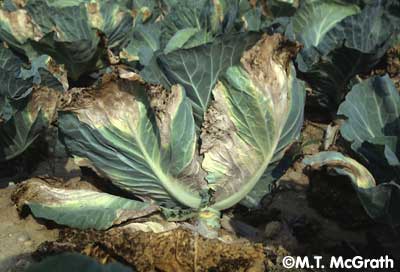There are many diseases that are common and "bother" our brassicas as detailed below:
CLUB ROOT
Pathogen - Plasmodiophora brassicae, a soilborne slime
mold-like parasite
Host – most members of the brassica family
Environment – Cool, wet, acidic soils
Signs & Symptoms – Roots will be partially or totally
swollen. If severe, water and nutrient uptake will be hindered and the plant
will show symptoms similar to water and nutrient deficiency – wilting and
yellowing of the leaves. Plants may also become stunted, show reduced head development,
or die.
Controls – Awareness of disease presence in the past is
important when developing a crop rotation. The parasite can survive in soil for
up to 10 years. Ensure soils are well drained and at a proper pH. Select
resistant varieties, when available. Remove infected crops from the field and
burn them – do not bury or feed to livestock, as the organism will persist and
be spread.
BLACK ROT
Pathogen – Xanthomonas campestris, a seedborne bacteria
Host – most members of the brassica family, particularly
cabbage and cauliflower
Environment – wet and warm (80-86 degrees Fahrenheit)
conditions
Signs & Symptoms – Initially, the plants will display
V-shaped lesions at margins of leaves. Leaf veins will become blackened. Leaves
will die off and drop. If the disease reaches the stems and affects the
vascular system of the plant, the plant will wilt.
Controls - A proper
crop rotation of three years between brassicas and planting in areas of good
soil drainage and aeration are important for prevention. Avoid overhead
irrigation. If plants are infected, remove from the field. Use of copper may
help prevent spread to healthy plants.
DOWNY MILDEW
Pathogen – Peronospora
parasitica, a fungal-like organism
Host – many brassicas, including cabbages, cauliflowers,
Brussels sprouts, radishes, swedes and turnips
Environment – favors cool, wet conditions
Signs & Symptoms – The disease starts with angular,
yellow spots on upper leaf surface. Eventually, these spots will turn brown.
Cotton-like spots will form on the underside of the leaves. Seedlings may also
be affected and will be totally covered in the mildew.
Controls - A proper
crop rotation is a starting point. Grow resistant varieties or disease-free
certified seeds. Ensure proper air circulation among plants. Remove infected
leaves and burn. Copper may reduce spread of disease.
ALTERNARIA LEAF SPOT
Pathogen – Alternaria brassicae & A. brassicicola,
seedborne pathogens easily spread by wind
Host – most brassicas
Environment – warm (77-86 degrees Fahrenheit), wet weather
Signs & Symptoms – Leaf spots start as pinpoint yellow
areas, expanding to up to 5cm in diameter. As these spots enlarge, the centers
display dark concentric rings. Browning of the heads in broccoli and
cauliflower may also be seen.
Controls – A proper crop rotation is a good start. Use
disease-free seed. Avoid overhead irrigation.
References:
http://en.wikipedia.org/wiki/Clubroot
(for image)




No comments:
Post a Comment